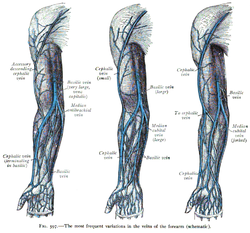Cephalic vein
| Cephalic vein | |
|---|---|

Superficial veins of the upper limb
|
|

The most frequent variations of the veins of the forearm.
|
|
| Details | |
| Source | Dorsal venous network of hand |
| Drains to | Axillary vein and median cubital vein |
| Artery | Deltoid branch of thoracoacromial artery |
| Identifiers | |
| Latin | Vena cephalica |
| Dorlands /Elsevier |
v_05/12849786 |
| TA | A12.3.08.015 |
| FMA | 13324 |
|
Anatomical terminology
[]
|
|
In human anatomy, the Cephalic vein (also known as the antecubital vein) is a superficial vein in the arm.
It communicates with the basilic vein via the median cubital vein at the elbow and is located in the superficial fascia along the anterolateral surface of the biceps brachii muscle.
Near the shoulder, the cephalic vein passes between the deltoid and pectoralis major muscles (deltopectoral groove) and through the deltopectoral triangle, where it empties into the axillary vein.
The cephalic vein is often visible through the skin, and its location in the deltopectoral groove is fairly consistent, making this site a good candidate for venous access. Permanent pacemaker leads are often placed in the cephalic vein in the deltopectoral groove. The vein may be used for intravenous access, as large bore cannula may be easily placed. However, the cannulation of a vein as close to the radial nerve as the cephalic vein can sometimes lead to nerve damage.
Ordinarily the term cephalic refers to anatomy of the head. When Persian physician Ibn Sīnā's Canon was translated into medieval Latin, cephalic was mistakenly chosen to render the Arabic term al-kífal, meaning "outer".
...
Wikipedia
